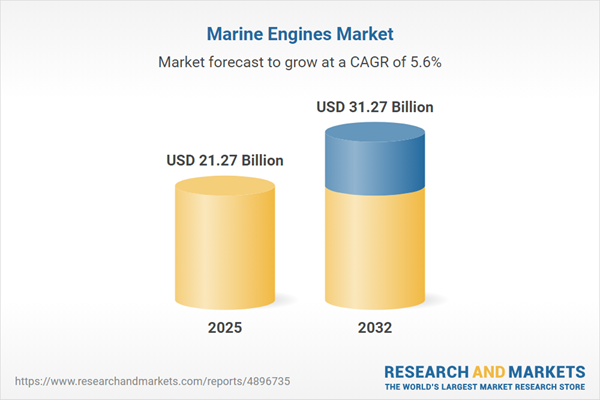Speak directly to the analyst to clarify any post sales queries you may have.
The marine engines market is rapidly evolving, requiring industry leaders to anticipate technological shifts and regulatory compliance challenges. With global regulations tightening and innovation accelerating, actionable, data-backed market intelligence is crucial for organizations aiming to maintain a resilient operational posture and capture new growth opportunities.
Market Snapshot: Marine Engines Market Size and Growth Overview
The marine engines market expanded from USD 20.15 billion in 2024 to USD 21.27 billion in 2025 and is projected to reach USD 31.27 billion by 2032, reflecting a sustained CAGR of 5.64%. This upward trajectory underscores a robust demand for next-generation propulsion technologies across commercial, military, fishing, and recreational vessels worldwide. Advancements in engine designs and regulatory-driven upgrades are reinforcing the market’s relevance in both mature and emerging marine economies, supporting fleet renewal and efficiency gains.
Scope & Segmentation: Coverage Across Core Market Dimensions
- Product Types: Inboard, Jet Drive, Outboard, Stern Drive. These categories serve vessel manufacturers, refit specialists, and operators requiring propulsion solutions tailored for operational performance and hull design.
- Fuel Types: Diesel, Electric, Gasoline. The mixed fuel landscape enables marine clients to align engine specification with emission targets, operating costs, and maintenance considerations.
- Applications: Commercial, Fishing, Military, Recreational. Each sector has distinct demands, from efficiency and uptime in commercial fleets to reliability in defense and simplicity for leisure crafts.
- Distribution Channels: Aftermarket, OEM. Original equipment manufacturers drive innovation in propulsion integration, while aftermarket channels provide essential upgrades and maintenance support.
- Geographies: Americas (including United States, Canada, Mexico, Brazil, Argentina, Chile, Colombia, Peru), Europe, Middle East & Africa (encompassing United Kingdom, Germany, France, Russia, Italy, Spain, Netherlands, Sweden, Poland, Switzerland, United Arab Emirates, Saudi Arabia, Qatar, Turkey, Israel, South Africa, Nigeria, Egypt, Kenya), and Asia-Pacific (with China, India, Japan, Australia, South Korea, Indonesia, Thailand, Malaysia, Singapore, Taiwan). This broad coverage enables comprehensive analysis of local policies, supply chain trends, and end-user behaviors by region.
- Technology Focus: Digital twins, predictive maintenance, exhaust aftertreatment, application of hydrogen and alternative fuels, connectivity, and modular engine architectures address both regulatory and lifecycle cost optimization imperatives.
- Featured Companies: Wärtsilä Corporation, MAN Energy Solutions SE, Rolls-Royce Power Systems GmbH, Caterpillar Inc., Cummins Inc., Yanmar Co., Ltd., Mitsubishi Heavy Industries, Ltd., Volvo Penta AB, Kawasaki Heavy Industries, Ltd., Hyundai Heavy Industries Co., Ltd. Key players leverage extensive R&D, pioneering new propulsion technologies and driving adoption globally.
Key Takeaways: Strategic Insights for Senior Leaders
- Digitalization and decarbonization are shaping both research priorities and investment allocation, accelerating the development of clean propulsion models and shifting competitive dynamics.
- Adoption of hybrid and electric propulsion is increasing as stakeholders respond to stricter emission standards and capitalize on ongoing port infrastructure modernization.
- Pioneering marine operators are actively piloting alternative fuel platforms, including hydrogen and biofuels, supported by evolving international fuel regulations that foster innovation.
- Connected maintenance analytics and artificial intelligence are redefining operational efficiency, supporting data-driven lifecycle management and reducing unplanned downtime.
- Segment-specific needs are distinct: commercial operators prioritize efficiency, military clients demand robust redundancy, and recreational buyers seek quiet operation and low-maintenance platforms.
- Collaborative strategies, such as supplier diversification and strategic alliances, are becoming integral as industry players mitigate geopolitical and supply chain risks.
Tariff Impact: Navigating the 2025 U.S. Measures
New U.S. tariffs taking effect in 2025 are driving companies to adapt global marine engine supply chains. Senior leaders are prioritizing regional sourcing, forming partnerships with domestic suppliers, and embracing modular production to minimize cost pressures. These responses help safeguard continuity and optimize spend, with renewed emphasis on supply chain resilience and procurement flexibility amid regulatory shifts.
Methodology & Data Sources
This research integrates secondary data analysis, direct interviews with sector leaders, and thorough data triangulation. Technical documentation, regulatory guidance, and benchmarking underpin the findings, while expert review ensures all recommendations meet the needs of strategic decision-makers.
Why This Report Matters: Actionable Intelligence for Decision-Makers
- Equip your organization to anticipate and respond proactively to emerging propulsion technologies and regulatory developments affecting investment and procurement.
- Assess opportunities and risks across core marine engine segments—including advances in fuel alternatives, evolving architectures, and regional supply chain dynamics—to support strategic alignment with the market’s trajectory.
- Leverage competitive landscape insights to inform positioning, collaboration decisions, and robust supply chain planning, ensuring operational readiness in a fast-changing environment.
Conclusion
The marine engines market is advancing through technological innovation, new regulations, and supply chain adaptation. This report delivers the insights and clarity leaders require to address complexity, drive transformation, and sustain long-term growth in a competitive landscape.
Additional Product Information:
- Purchase of this report includes 1 year online access with quarterly updates.
- This report can be updated on request. Please contact our Customer Experience team using the Ask a Question widget on our website.
Table of Contents
3. Executive Summary
4. Market Overview
7. Cumulative Impact of Artificial Intelligence 2025
List of Figures
Samples

LOADING...
Companies Mentioned
The key companies profiled in this Marine Engines market report include:- Wärtsilä Corporation
- MAN Energy Solutions SE
- Rolls-Royce Power Systems GmbH
- Caterpillar Inc.
- Cummins Inc.
- Yanmar Co., Ltd.
- Mitsubishi Heavy Industries, Ltd.
- Volvo Penta AB
- Kawasaki Heavy Industries, Ltd.
- Hyundai Heavy Industries Co., Ltd.
Table Information
| Report Attribute | Details |
|---|---|
| No. of Pages | 181 |
| Published | October 2025 |
| Forecast Period | 2025 - 2032 |
| Estimated Market Value ( USD | $ 21.27 Billion |
| Forecasted Market Value ( USD | $ 31.27 Billion |
| Compound Annual Growth Rate | 5.6% |
| Regions Covered | Global |
| No. of Companies Mentioned | 11 |









